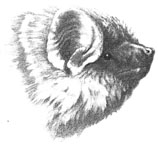|
Habitat Atlas for Wildlife at Risk
Western Red Bat
Lasiurus blossevilli

Western
Red Bat
|
- Total length: 11.0 cm; wingspan: 28.0
cm; weight:11 grams.
- Ears: 1.0-1.5 cm long.
- Easily recognized by the unique fur colour varying
from orange to rusty red; males tend to be brighter
in colour.
- Dense fur on back is long and soft; underside
is paler.
- Upper surface of tail and hind feet are thickly
furred.
Habitat map not available.
Status:
British Columbia Red List
Special Significance
The Western Red Bat appears to be one of the rarest
bats in the province and Canada, known from the Skagit
Valley and Okanagan Falls. The development of management
plans to protect this rare bat requires further research
to delimit its range in British Columbia and identify
critical roosting and foraging habitats. This species
continues to be threatened by habitat loss as remaining
riparian woodlands are cleared for development. Conservation
of riparian areas, which support a diversity of insects,
is an important factor.
Distribution
- In British Columbia, recorded from the Skagit Valley and Okanagan
Valley, near Okanagan Falls.
- Restricted to lower elevations.
Habitat
- Western Red Bats are associated with large deciduous trees along
rivers (riparian habitat); cottonwoods and aspen
are presumably used for roosting.
- Red Bats hunt over streams and forest openings and
clearings.
- Migration and winter range of this species is poorly
documented; bats may overwinter in British Columbia
instead of migrating.
- Western Red Bats overwinter in the coastal lowlands
of California, roosting in large shrubs and fruit
trees.
Reproduction
- Very little is known about breeding.
- Eastern Red Bats mate in flight during fall migration.
- Western Red Bats give birth in June or early July;
three young are most common.
- Young bats remain at the roost while the female hunts
at night, however she carries her young when changing
roost locations; the young can fly at 3 to 6 weeks.
Food Habits
- Large moths are the main prey item, but also eat beetles and grasshoppers.
- Red Bats are very late feeders; foraging one or two
hours after sunset.
- A Red Bat usually catches its prey in the tail membrane
which can be curled into a pouch; these bats
are fast flyers.
Interesting Facts
- Despite their bright colour, Western Red Bats are well-concealed
when roosting because they resemble dead leaves.
- Eastern Red Bats will eavesdrop on the sonar calls
of other Red Bats to locate potential insect prey.
- In contrast to bats that hibernate where the temperature
is relatively stable, Red Bats hibernate in trees
where they are exposed to fluctuations in temperature; their thick
fur, small ears, and furred
tail help to minimize heat loss.
Encounters
- Bat encounters are most common during the summer when bats enter
houses and sheds through open windows, chimneys
or wall cracks. A flying bat will generally leave on its own if
windows and doors are
opened and lights are turned off.
- Avoid handling bats, however if it is necessary, wear
leather gloves. If a bat is asleep in your house,
a pillow case can be used to gently grasp the bat (wear thick gloves
as a precaution
against bites). The bat will be trapped when the
case is turned inside out; once outdoors, the bat can be released.
- Exclude bats from buildings by sealing up the place
of entry after bats leave at night to feed. Be
sure not to seal off a nursery colony during summer or the flightless
young will perish.
Ideally, all openings should be sealed in the winter
when the bats have left the structure to hibernate elsewhere. If
you want to encourage
bats into your neighbourhood, consider building
a bat house.
- While bats, like other mammal species, can carry rabies,
scientists estimate that only 1 out of every 200
bats are affected. The best precautions are to avoid handling bats
or any other wild
animals, and make sure pets are vaccinated.
- Unfortunately, bats tend to be viewed as undesirable
by many people, when in fact they perform invaluable
ecological roles, such as keeping insect populations in check. All
bats are protected
under the British Columbia Wildlife Act and cannot
be indiscriminately killed.
Threats
- Extensive land development in the Okanagan has
eliminated or fragmented lowland riparian
habitat.
- Cottonwood and aspen forest removal.
- Livestock seeking shelter in aspen copses trample
seedlings and other riparian tress and shrubs.
- Their low reproductive rate means a slow recovery
rate after disturbances.
- Use of pesticides may reduce availability of insect
prey.
Management Considerations
- Avoid the use of pesticides, particularly near
wetlands and riparian areas.
- Protect remaining cottonwood stands and aspen
groves.
- Discourage logging in cottonwoods stands and
riparian areas.
- Restrict cattle access to riparian areas to allow
regeneration of trees and shrubs.
|
References
1. Nagorsen, D.W. and R.M. Brigham. 1993. Bats of British Columbia.
Royal British Columbia Museum Handbook, Victoria, British Columbia
2. Holroyd, S.L., R.M.R. Barclay, L.M. Merk and R.M.
Brigham. 1994. A survey of the bat fauna of the dry interior of British
Columbia. Ministry of Ministry of Water, Land and Air Protection.
Victoria, British Columbia.
3. van Zyll de Jong, C.G. 1985. Handbook of Canadian
mammals, Vol. 2. Bats. National Museum of Natural Sciences, National
Museums of Canada, Ottawa.
|